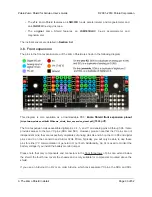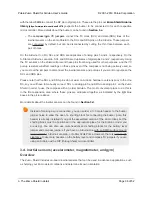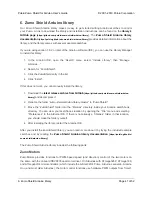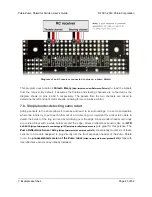
with the label
32U4
to connect the BZ pin to digital pin 6. These are the pins our
[https://www.pololu.com/docs/0J57/6]
expects the buzzer to be connected to for each respective
microcontroller. More details about the buzzer can be found in
• The
compass/gyro I²C jumpers
connect the I²C clock (SCL) and data (SDA) lines of the
inertial sensors on the Zumo Shield to the SCL and SDA pins on the Arduino. These jumpers
are connected by default, but can be disconnected by cutting the thin trace between each
pair of holes.
On the Arduino Uno R3, SCL and SDA are duplicates of analog pins 5 and 4, respectively. On the
A-Star and Arduino Leonardo, SCL and SDA are duplicates of digital pins 3 and 2, respectively. Using
the I²C sensors on the shield will prevent these pins from being used for other purposes, and the I²C
pull-up resistors will affect readings on these pins even if the compass is not being actively used, so
you must cut the jumpers to disconnect the inertial sensors and pull-ups if you want to repurpose the
SCL and SDA pins.
Please note that the SCL and SDA pins do not exist on Arduino hardware versions prior to the Uno
R3, so you will have to manually connect SCL to analog pin 5 and SDA to analog pin 4 on the Zumo
Shield in order to use the compass with an older Arduino. The most convenient place to do this is
in the front expansion area, where these pins are all located together, as indicated by the light blue
boxes in the picture above.
More details about the inertial sensors can be found in
.
Instead of making a wire connection, you can solder a 1×3 male header to the buzzer
jumper holes to allow the use of a shorting block for connecting the buzzer (note: this
header is already installed if you got the assembled version of the Zumo robot, but the
shorting block must be positioned in the appropriate place for the Arduino model you
are using). You can also use male headers and shorting blocks for the battery level
jumper and compass jumpers if you have an Arduino Uno with an SMD (surface mount)
microcontroller, Arduino Leonardo, or A-Star 32U4 Prime. However, there is not enough
clearance to use male headers on the battery level and compass I²C jumpers if you are
using an Arduino with a DIP (through-hole) microcontroller.
3.d. Inertial sensors (accelerometer, magnetometer, and gyro)
Overview
The Zumo Shield includes on-board inertial sensors that can be used in advanced applications, such
as helping your Zumo detect collisions and determine its own orientation.
Pololu Zumo Shield for Arduino User’s Guide
© 2001–2019 Pololu Corporation
3. The Zumo Shield in detail
Page 36 of 52






























